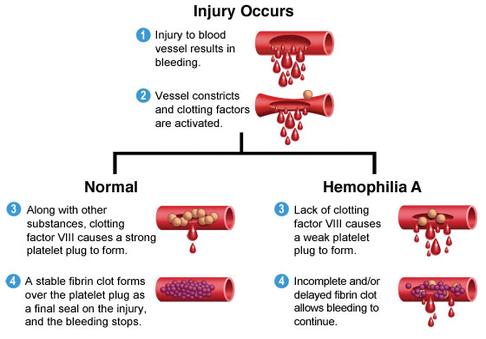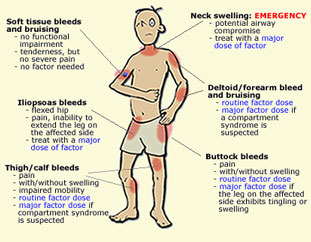विश्व हीमोफिलिया जागरूकता दिवस १७ अप्रैल
World Hemophilia Day is observed on 17 th April to raise the awareness of hemophilia and other bleeding disorders.
हीमोफिलिया एक अनुवांशिक विकार है जिसमे पीड़ित व्यक्ति को किसी प्रकार की चोट लग जाने पर अधिक देर तक रक्तस्त्राव होता है . हीमोफिलिया से ग्रस्त व्यक्ति के शरीर में क्लॉटिंग फैक्टर्स ( जो रक्त-वाहिकाओं पर किसी प्रकार की चोट लगने पर रक्तस्त्राव को बंद कर देते है ) की कमी होती है, अतः इन व्यक्तियों में अधिक देर तक रक्त का बहना जारी रहता है .
Haemophilia is a group of hereditary genetic disorders that impair the body’s ability to control blood clotting or coagulation, which is used to stop bleeding when a blood vessel is broken.
Hemophilia is a bleeding problem and the people with hemophilia can bleed for a longer time as their blood does not have enough clotting factor, a protein in blood that controls bleeding.
Hemophilia is usually inherited, the hemophilia gene is passed down from parent to a child. The genes for hemophilia A and B are on the X chromosome. For this reason, hemophilia is called an X-linked (or sex-linked) disorder. Girls who inherit the gene rarely get the condition, but as carriers of the gene they can pass it to their children.
हीमोफिलिया A और B से पीड़ित व्यक्ति के अल्टेर्ड जीन्स x क्रोमोसोम्स पर होते है, जिसके कारण हे इसे X – लिंक्ड डिसऑर्डर भी कहा जाता है.
Sometimes hemophilia can occur when there is no family history of it. This is called sporadichemophilia. About 30% of people with hemophilia did not get it through their parent’s genes. It was caused by a change in the person’s own genes.
हीमोफिलिया से पीड़ित स्त्रियों में इसके लक्षण नहीं दिखाई देते है बल्कि वे सिर्फ एक करियर के रूप में अपनी संतान को इसके जीन्स ट्रांसफर करती है.
According to its Severity, Hemophilia can be classified into:
1. Mild:
People with mild hemophilia usually bleed only as a result of surgery or major injury. They do not bleed often and, in fact, may never have a bleeding problem.
2. Moderate:
People with moderate hemophilia bleed less frequently, about once a month. They may bleed for a long time after surgery, a bad injury, or dental work but rarely experience spontaneous bleeding.
3. Severe:
People with severe hemophilia usually bleed frequently into their muscles or joints. They may bleed one to two times per week. Bleeding is often spontaneous and it happens for no obvious reason.
Signs and Symptoms of External Bleeding:
* Bleeding in the mouth from a cut or bite or from cutting or losing a tooth
* Nosebleeds for no obvious reason
* Heavy bleeding from a minor cut
* Bleeding from a cut that resumes after stopping for a short time
हीमोफिलिया के लक्षण :
* बाह्य रक्तस्त्राव :
* बिना वजह नाक से खून आना
* दांत टूटने पर अधिक मात्रा में रक्त बहना
* छोटी चोट अथवा कट पर भी अधिक मात्रा में और देर तक रक्तस्त्राव होना
*किसी चोट अथवा कट लगने पर एक बार रखत्स्त्राव बंद हो जाने के कुछ
समय बाद फिर से ब्लीडिंग होना
Signs and Symptoms of Internal Bleeding:
Blood in the urine
Blood in the stool
Large bruises
Bleeding in the knees, elbows or around other joints
Swollen and Painful Joints
अंदरूनी रक्तस्त्राव :
* मूत्र / पेशाब में खून आना
*मल में रक्त आना
*जोड़ों ( घुटने, कोहनी ) पर बिना किसी प्रकार की चोट के लाल या नीले निशान पड़ना
*जोड़ों में सूजन और दर्द
Medical Management:
For both types of Hemophilia, getting quick treatment for bleeding is of utmost important. Early treatment can limit damage to the organs of the body.
1.Treatment With Replacement Therapy
The main treatment for hemophilia is called replacement therapy. Concentrates of clotting factor VIII (for hemophilia A) or clotting factor IX (for hemophilia B) are slowly dripped or injected into a vein. These infusions help replace the clotting factor that’s missing or low.
Factor replacement therapy helps blood to clot and prevents long-term joint damage due to bleeding. It can be given while a bleeding episode is happening to promote clotting, or in regularly scheduled treatments to keep the blood healthy.
2. Desmopressin
It is a man-made hormone used to treat people who have mild hemophilia A.
3. Antifibrinolytic medicines
4. Pain medicines along with steroids
5. Physical therapy may be used to reduce pain and swelling in an affected joint
6. Gene Therapy
Don’t Forget to look out for above mentioned signs and symptoms..
Remember that the Earlier the Diagnosis, the Better will be Prognosis…
So, Keep Your Spirits High and Never Give Up…
Dr. P Pathak
facebook.com/swavalambanrehab
in.linkedin.com/in/swavalambanrehab
twitter.com/swavalambanrehb





 +91-94 24 851 514
+91-94 24 851 514






